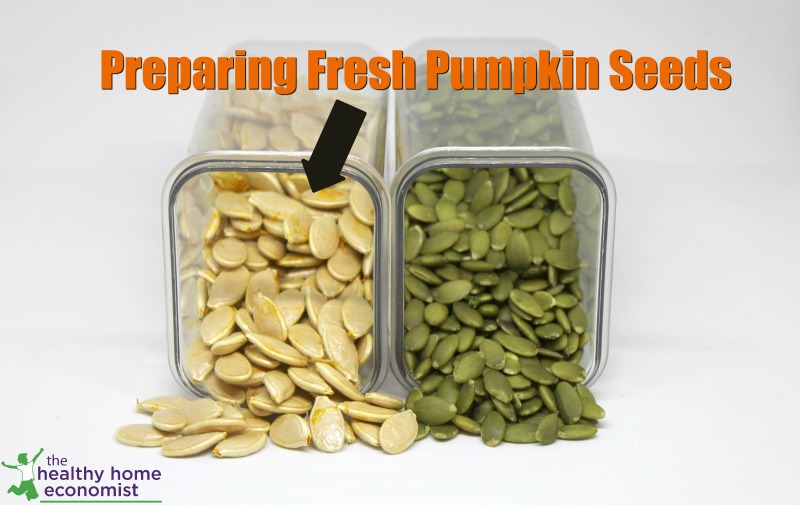Table of Contents[Hide][Show]

Have you ever noticed that the seeds inside a pumpkin are white compared with pumpkin seeds at the store which are usually green? If so, you might be wondering how to prepare those fresh pumpkin seeds for eating like you would other soaked seeds.
The good news is that you can definitely eat those white pumpkin seeds! And, pumpkin seeds whether organic or not are quite expensive…about $8 per pound in my neck of the woods. So, definitely don’t throw them out!
A good-sized pumpkin will yield about one-half to one cup of seeds. The value of these seeds more than pays for the cost of the pumpkin itself!
The effort to get them ready to eat is quite easy too as I show you in the video below.
Green vs White Pumpkin Seed Benefits
There is a single nutritional difference between green and fresh, white pumpkin seeds. In a word, it is fiber.
For example, a quarter cup (32 grams or about a palmful) of fresh pumpkin seeds with the hulls has about 6 grams of fiber. The same amount of shelled raw pumpkins seeds, aka pepitas, has about 2.2 grams of fiber…approximately one-third the amount. (1, 2)
So, if you are looking to increase the fiber in your diet, eating fresh pumpkin seeds with the shells on is a good option for snacking.
Another benefit of eating white pumpkin seeds with the hulls on is that this fiber is anti-parasitic.
In particular, pumpkin seed hull fiber is effective as a natural dewormer of the digestive tract if you consume small amounts on a regular basis.
This is due to the fact that the hulls contain a chemical called cucurbitacin that causes paralysis in worms such as tapeworms and roundworms. This allows them to be more easily expelled by the body via the stool. (3, 4)
Preparing Fresh Pumpkin Seeds
If more fiber that has anti-parasite properties sounds good to you, then here is how to get those white pumpkin seeds ready for snacking in no time!
- Place one cup of fresh pumpkin seeds in a glass bowl with enough filtered water to cover.
- Stir in one-half tablespoon of sea salt.
- Leave uncovered on the counter for about 8 hours or overnight. This makes the seeds much more digestible by eliminating anti-nutrients like phytic acid.
- Drain the water thoroughly and spread the wet seeds evenly on a large cookie sheet. You do not need to rinse, but you can if you wish to remove the salt.
- Dry the seeds in a warm oven that is set to about 150 F/ 66 C for a few hours until thoroughly dry. You may also use a food dehydrator.
- Store fresh seeds in an airtight container in the pantry or refrigerator.

Other Uses
If you have a digestive condition that is aggravated by fiber, then it is best to stick with green pumpkin seeds, aka pepitas, from the health food store.
I don’t recommend trying to remove the hull of the fresh white pumpkin seeds as it is too time-consuming.
Instead, I suggest pulsing the fresh seeds in a food processor once or twice to coarsely break them up. You can also use an electric coffee grinder.
Then, feed the chopped up white seeds to your backyard chickens or ducks. They love them! Guinea pigs and goats also really enjoy them in my experience.
If you don’t have any type of pet that can benefit from eating the fresh seeds, at least compost them so that the minerals in the seeds can enrich your garden soil.
Video Demonstration
The short video below demonstrates how to prepare white pumpkin seeds for eating.
References
(1) Shelled Pumpkin Seeds (Pepitas) Nutritional Data
(2) Whole Pumpkin Seeds Nutritional Data
(3) Usefulness of Pumpkin Seeds in treating Tapeworm Infections
(4) Pumpkin Seeds: Do They Control Worms?








You don’t have to add whey or something acidic to these seeds to help remove the phytic acid?
Hi Sarah, this is pretty useful. I got tons of pumpkin seeds in the fall, and I am going to take this method to deworm. I am just wondering if I can just dry the soaked seeds in the sun as I don’t have an oven.
It would probably work if you live in a fairly hot and dry climate.
Hi Sarah! What about the seeds in other winter squash – can we eat those too?
Yes you can! They taste a bit different than pumpkin seeds, so it’s a nice variety to switch up the source of your pumpkin/squash seeds 🙂
I have avoided eating fresh pumpkin seeds for year because I didn’t think they could be soaked/sprouted. So this is very interesting information and I’m going to give fresh pumpkin seeds a try again this year. When I used to make them, before knowing about soaking seeds, I would just rinse them off, add a little oil and salt and then roast. Are the seeds already salted from their soak in the saltwater or does the salt rinse off?
The salt does rinse off. I don’t rinse the seeds after soaking though … I just dehydrate in a warm oven. You can toast them too at a higher temperature, but you will lose the benefits of the rawness.